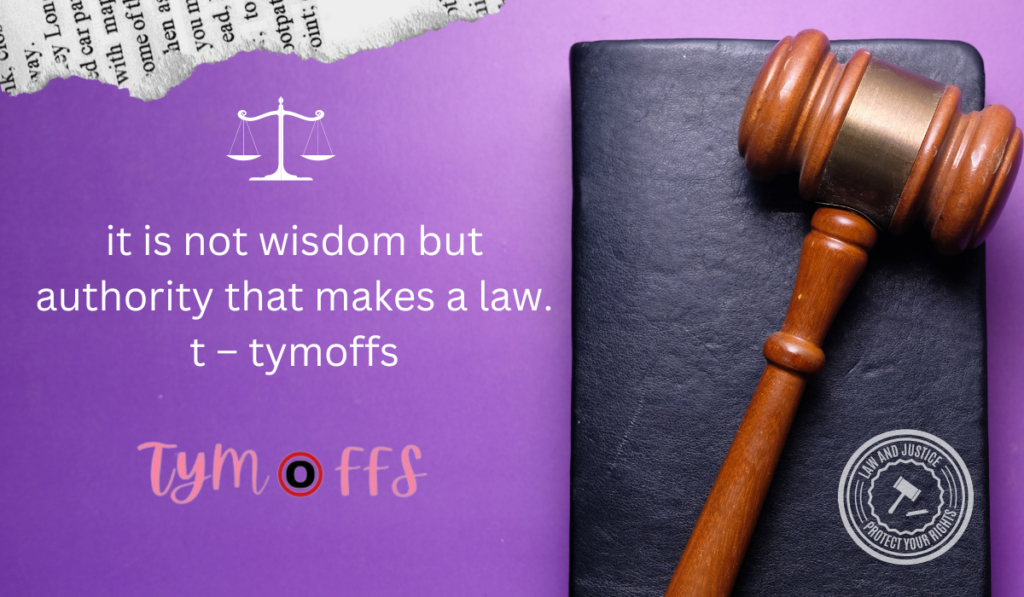“It is not wisdom but authority that makes a law.” — Tymoff
This quote highlights the difference between wisdom, which is the accumulation of knowledge and insight, and authority, which is the power or right to enforce laws, exact obedience, or make decisions. While wisdom is often associated with good judgment and the pursuit of truth, authority is connected to the power wielded by individuals or institutions.
The Role of Wisdom in Leadership
Wisdom in leadership involves the ability to discern the best course of action, not only for short-term gains but for long-term sustainability. Wise leaders are those who consider the broader implications of their decisions, seek counsel from others, and act with integrity. They understand the complexities of human nature and use their insights to foster environments where people can thrive and contribute effectively.
The Authority Dilemma
Authority, while necessary for maintaining order and ensuring that rules are followed, can lead to dilemmas when it’s not exercised with consideration and ethical grounding. The authority dilemma arises when leaders must balance the use of power to enforce laws and policies against the potential for overreach or the erosion of trust among those they govern. This tension can challenge leaders to act fairly and justly, ensuring their authority is recognized as legitimate.
Authority vs. Wisdom
The interplay between authority and wisdom is crucial in governance and leadership. While authority can enforce compliance, wisdom ensures that the laws and decisions are just and beneficial. Leaders must strive to achieve a balance where their decisions are not only accepted because of their authority but also respected because of their wisdom.
Volume Table:
| Aspect | Authority | Wisdom |
| Basis | Power and right | Knowledge and insight |
| Focus | Compliance and enforcement | Understanding and good judgment |
| Goal | Order and obedience | Long-term good and sustainability |
| Challenges | Potential for overreach | Complexity of issues |
| Outcome | Enforcement of laws | Respected and fair decisions |
This table contrasts the foundational aspects of authority and wisdom, showing how each influences leadership and governance. While authority is essential for enforcing laws and maintaining order, wisdom is crucial for ensuring these laws are fair and for the betterment of society.
Learn to Sit Back and Observe. Not Everything Needs a Reaction – Tymoff
 In a world that often values quick responses and engagement, there is a profound strength in learning to sit back and observe. This approach doesn’t just apply to personal interactions but extends to our consumption of media and news. The advice, “Not everything needs a reaction,” highlights the importance of thoughtful consideration before action.
In a world that often values quick responses and engagement, there is a profound strength in learning to sit back and observe. This approach doesn’t just apply to personal interactions but extends to our consumption of media and news. The advice, “Not everything needs a reaction,” highlights the importance of thoughtful consideration before action.
Why is This Important?
Taking a moment to observe rather than react immediately can lead to better decision-making and more meaningful interactions. It reduces the likelihood of misunderstandings and conflicts, and can help in managing one’s emotional responses. By not reacting immediately, you provide yourself the opportunity to assess the situation more thoroughly and respond more effectively.
Step-by-Step Guide to “Learn to Sit Back and Observe. Not Everything Needs a Reaction – Tymoff”
- Pause Before Reacting: Whenever you’re presented with information or a situation that typically triggers an immediate response, take a deliberate pause. Even a few seconds can make a significant difference in how you perceive and engage with the situation.
- Assess the Importance: Ask yourself how important it is for you to engage with this situation. Does it warrant a response? If yes, what kind of response would be most appropriate? This helps in prioritizing your actions based on actual need rather than impulse.
- Decide on a Course of Action: After a brief assessment, decide whether to respond, how to respond, or if it is best to let the situation pass without action. This final step reinforces the power of choice in your reactions and interactions.
The Art of Non-Reaction:
Embracing non-reaction doesn’t mean becoming passive or disengaged. Instead, it’s about becoming more conscious of our reactions and the implications they have. This approach encourages a more balanced and reflective stance in life, which can lead to greater peace of mind and improved interpersonal relations. Non-reaction is an art that involves recognizing when it’s beneficial to engage and when it’s wise to step back and observe.
Self-Control is Strength. Calmness is Mastery. You – Tymoff
 Self-control and calmness are crucial elements that contribute significantly to personal and professional success. By mastering these qualities, individuals can navigate challenges more effectively and make decisions that align with their long-term goals.
Self-control and calmness are crucial elements that contribute significantly to personal and professional success. By mastering these qualities, individuals can navigate challenges more effectively and make decisions that align with their long-term goals.
Why Self-Control is Strength?
Self-control is a fundamental strength because it enables individuals to manage their emotions, behaviors, and desires in the face of temptations and impulses. By exercising self-control, people can avoid rash decisions and actions that may lead to negative consequences. This strength is vital in maintaining focus and perseverance, especially when pursuing long-term objectives. It helps in resisting distractions and staying aligned with personal values and goals.
How to Establish or Improve Self-Control or Self-Discipline?
Improving self-control is a gradual process that involves developing habits and strategies that enhance your ability to regulate your thoughts and actions. Here are three steps to help you establish or improve your self-control:
- Awareness and Identification: Recognize the situations in which you typically lose control and understand what triggers those reactions. This awareness is the first step in managing your impulses.
- Set Clear Goals and Create a Plan: Define what you want to achieve in terms of self-discipline. Set specific, measurable, and realistic goals. Develop a plan that outlines the steps you will take to reach these goals. This might include scheduling activities that require self-control, like meditation or exercise.
- Practice and Persistence: Self-control is like a muscle that needs to be exercised regularly to become stronger. Consistently practicing self-discipline, even in small everyday tasks, can significantly improve your ability to control your impulses over time. Don’t get discouraged by setbacks—perseverance is key.
Practical Application in Everyday Life:
Incorporating self-control into everyday life can dramatically enhance one’s quality of life and ability to achieve goals. Here are some practical applications:
- Financial Management: Practicing self-control can help you manage your finances better, avoiding impulsive purchases and saving for future needs.
- Healthy Living: Self-discipline plays a critical role in maintaining a healthy lifestyle. It helps in sticking to exercise routines and healthy eating habits.
- Work and Productivity: In the workplace, self-control helps in managing time effectively, meeting deadlines, and staying focused amidst distractions.
By embracing the principles of self-control and calmness, you can master yourself and pave the way for a fulfilling and successful life.
A True Relationship is Two Imperfect People Refusing to Give Up on Each Other – Tymoff
 In a world obsessed with perfection, the true essence of a loving relationship is often misunderstood. It’s not about finding a flawless partner but about embracing each other’s imperfections and refusing to give up. This concept, beautifully summarized in the saying “A true relationship is two imperfect people refusing to give up on each other,” provides a realistic perspective on what it means to be in a loving, enduring partnership.
In a world obsessed with perfection, the true essence of a loving relationship is often misunderstood. It’s not about finding a flawless partner but about embracing each other’s imperfections and refusing to give up. This concept, beautifully summarized in the saying “A true relationship is two imperfect people refusing to give up on each other,” provides a realistic perspective on what it means to be in a loving, enduring partnership.
The Myth of Perfection
The idea that a perfect relationship exists can be damaging. It creates unrealistic expectations and places undue pressure on both partners to conform to an ideal that doesn’t exist. In reality, every individual has flaws and makes mistakes. The beauty of a true relationship lies not in perfection but in accepting and loving a person despite these imperfections. This acceptance fosters a deeper, more meaningful connection, as partners learn to appreciate the unique qualities that make each other who they are.
A True Relationship is Two Imperfect People Refusing to Give Up on Each Other – Tymoff: Step-by-Step Guide
Building a relationship where both partners are committed to each other despite their imperfections involves several key steps:
- Open Communication: Ensure that there is a continuous flow of open and honest communication. This helps in understanding each other’s thoughts, feelings, and imperfections.
- Mutual Respect: Respect each other’s differences and vulnerabilities. Recognize that these differences are what make your partner unique.
- Commitment to Growth: Embrace challenges as opportunities for growth. Working through difficulties together strengthens the bond and reinforces the commitment to not give up on each other.
The Role of Empathy in Understanding Each Other
Empathy plays a crucial role in any relationship. It involves putting oneself in the other person’s shoes and understanding their feelings and perspectives. In the context of a relationship between two imperfect people, empathy helps partners to be more forgiving and less judgmental. It fosters a supportive environment where both individuals feel safe to express their true selves, including their fears and weaknesses. By nurturing empathy, couples can create a stronger, more resilient relationship that thrives on mutual understanding and unconditional support.
Build Insane Triceps by Doing Skull Crushers – Laz – Tymoff
 Skull crushers, also known as lying triceps extensions, are a fantastic exercise for building formidable triceps muscles. This strength-training move involves lying on a bench and lifting a weight from behind the head to above the chest, specifically targeting the triceps muscles at the back of the upper arms. It’s a popular choice for those looking to add serious mass and definition to their triceps.
Skull crushers, also known as lying triceps extensions, are a fantastic exercise for building formidable triceps muscles. This strength-training move involves lying on a bench and lifting a weight from behind the head to above the chest, specifically targeting the triceps muscles at the back of the upper arms. It’s a popular choice for those looking to add serious mass and definition to their triceps.
Mastering the Skull Crushers Technique
To maximize the effectiveness of skull crushers and minimize the risk of injury, proper form is crucial:
- Positioning: Lie flat on a bench with your feet firmly planted on the ground. Start with the weight directly above your chest, holding it with an overhand grip.
- Movement: Slowly lower the weight toward your forehead by bending the elbows while keeping your upper arms stationary. The movement should feel controlled and focused.
- Execution: Extend your arms back to the starting position, focusing on using your triceps to move the weight. Avoid using momentum or letting your elbows flare out.
The Benefits of Including Skull Crushers in Your Workout Routine
Incorporating skull crushers into your fitness regimen can yield significant benefits:
- Enhanced Triceps Strength and Size: This exercise isolates the triceps effectively, leading to increased muscle size and strength due to its range of motion and intensity.
- Improved Arm Aesthetics: Well-defined triceps contribute to a more balanced and aesthetically pleasing arm appearance.
- Versatility: Skull crushers can be performed with various equipment, such as barbells, dumbbells, or E-Z curl bars, allowing for variations that keep your workouts engaging and challenging.
Importance of Proper Recovery and Nutrition
To reap the maximum benefits from skull crushers and any intensive training, focusing on recovery and nutrition is essential:
- Recovery: Proper rest periods between training sessions allow muscle fibers to repair and grow. Incorporate rest days and consider techniques like foam rolling or massage to aid recovery.
- Nutrition: Fueling your body with the right nutrients is critical. Increase your protein intake to support muscle repair and growth. Also, ensure a balanced diet rich in vitamins and minerals to aid overall wellness and performance.
Incorporating skull crushers into your routine with proper technique, and supporting your efforts with good nutrition and recovery strategies, can lead to impressive gains in triceps strength and appearance.
Meet Nala Cat: The Instagram Star with a Ton of Followers – Tymoff
 Nala Cat is not just a pretty face on your Instagram feed; she is a true sensation that has captured the hearts of millions with her adorable antics and expressive eyes. As one of the most famous cats on social media, Nala’s journey from a shelter kitten to an internet celebrity is not only inspiring but also a testament to the impact of pet adoption.
Nala Cat is not just a pretty face on your Instagram feed; she is a true sensation that has captured the hearts of millions with her adorable antics and expressive eyes. As one of the most famous cats on social media, Nala’s journey from a shelter kitten to an internet celebrity is not only inspiring but also a testament to the impact of pet adoption.
The Rise of Nala Cat
Nala’s story begins in a small animal shelter, where she was waiting for someone to give her a loving home. Adopted at five months old, she quickly adapted to her new life filled with affection and attention. Her owners began sharing her photos on Instagram, not knowing that she would soon become a global phenomenon. With her unique markings and endearing personality, Nala quickly amassed a large following, turning her into one of the most recognizable cats on the internet.
Making a Lasting Impact on Animal Welfare
Beyond her social media fame, Nala Cat uses her platform for a greater cause – advocating for animal welfare and shelter adoption. Through her posts and partnerships with animal organizations, she raises awareness about the importance of adopting pets and supports various initiatives aimed at improving the lives of animals in shelters. Nala’s influence helps to bring attention to the plight of countless animals waiting in shelters and encourages her followers to consider adoption first.
The Power of Personality
What truly sets Nala apart in the crowded space of pet influencers is her distinctive personality. Her owners have done a fantastic job of capturing her quirky traits, from her playful antics to her lazy day cuddles, making her relatable and lovable to her audience. This personal touch has not only endeared her to millions but also shown how pets can enrich our lives with their unique characters and unconditional love.
Through her social media presence, Nala Cat continues to charm people around the world while making a positive impact on animal welfare. Her story is a powerful reminder of how adopting a pet can change both the animal’s life and your own.
I Fear No One, but Respect Everyone – Tymoff
 In today’s fast-paced and often polarized society, the quote “I fear no one, but respect everyone” attributed to Tymoff serves as a powerful reminder of the importance of maintaining dignity and respect in all our interactions. This statement encapsulates a philosophy of strength and respect, suggesting a balanced approach to personal and professional relationships.
In today’s fast-paced and often polarized society, the quote “I fear no one, but respect everyone” attributed to Tymoff serves as a powerful reminder of the importance of maintaining dignity and respect in all our interactions. This statement encapsulates a philosophy of strength and respect, suggesting a balanced approach to personal and professional relationships.
I Fear No One but Respect Everyone – Tymoff, Significance of Both Parts of This Quote
The first part of the quote, “I fear no one,” emphasizes self-confidence and the refusal to be intimidated by others, regardless of their status or power. It speaks to the idea of standing firm in one’s values and beliefs without succumbing to fear. The second part, “but respect everyone,” underscores the importance of acknowledging the inherent worth and dignity of every individual. It’s a call to approach interactions with humility and openness, regardless of one’s own strength or confidence. Together, these principles foster an environment where mutual understanding and cooperation can thrive.
Respectful Disagreement: Embracing Differences
Embracing differences through respectful disagreement is crucial in a diverse society. It involves recognizing and appreciating the perspectives and experiences of others, even when they conflict with one’s own. This approach allows for constructive dialogues, where all parties feel heard and valued. It encourages the exchange of ideas in a way that promotes learning and growth, rather than creating divisions or hostilities.
The Power of Respect:
Respect is a fundamental cornerstone of effective communication and relationship-building. It influences social dynamics at multiple levels, from personal interactions to professional environments, and even on a global scale. Demonstrating respect can diffuse conflicts, enhance collaboration, and foster a culture of inclusivity and acceptance. The power of respect lies in its ability to transform interactions and to create a foundation for positive change and mutual understanding in society.



























